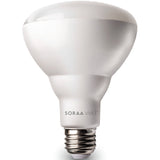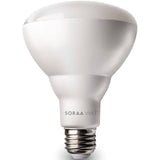LED Downlight Options for Small Commercial & Residential Applications
Posted by Dave on for ProLampSales

The number of recessed downlights in small commercial and residential environments often exceeds all other types of light fixtures in the building.
Tucked neatly inside the ceiling, these fixtures manage to be both an unobtrusive and an effective source of illumination for many types of spaces.
The traditional light source for these downlights has been the incandescent BR30 (3.75" diameter) or BR40 (5" diameter) reflector floods. Unlike architectural grade downlights, the typical small commercial and residential "recessed can" is simply a housing for electrical connections and for containing the trim and bulb. The bulb itself provides all the lighting optics.
Federal legislation mandated a phase out of many common incandescent light bulbs including (starting in 2012) reflector floods. The traditional 1000 hour life BR30 and BR40 bulbs are no longer manufactured. Certain incandescent/halogen variations of these bulbs, providing higher efficiency and longer life, meet Federal efficiency standards and can still be purchased. However, the market has generally moved to LED versions of these bulb shapes.
LED Reflector Flood Bulbs Offer Easy Upgrade

In this post we'll look at the LED options for the type of downlights using BR30 and BR40 reflector flood bulbs - the most common configuration for small commercial, institutional and residential applications.
The easiest and least expensive transition from inefficient incandescent BR30/BR40 bulbs to LED is simply to replace the incandescent bulbs with the LED equivalent. Typically, an 8 watt LED BR30 replaces a 65 watt incandescent BR30 bulb. A 12 to 14 watt LED BR40 replaces an 85 watt incandescent BR40.
These LED BR30 / BR40 bulbs will have a similar shape and dimensions as incandescent. They will produce the same warm light (2700K), with cooler appearing light versions also available (3000K to 6500K). They will also have the same dimming capability, although non-dimming versions can be purchased at a slightly lower cost. In addition these LED reflector floods will have a frosted face to provide diffuse light distribution and minimize glare.
Changing from incandescent to LED is as simple as changing the light bulb. LED BR30 and BR40 bulbs have the same medium screw base as incandescent. Unscrew and discard the incandescent, screw in the LED. Done.
Benefits of LED Compared to Incandescent Reflector Floods
With 8 watt LEDs producing the same light as 65 watt incandescent as well as providing a 25,000 hour rated life and full dimming, the performance advantages easily outweigh the added cost per bulb – $6 to $10 for BR30 LED versus $2 to $3 for the improved efficiency BR30 incandescent that are still available (prices as of late 2017).
What to look for when shopping for LED reflector flood replacements:
Lumens: a 65 watt incandescent reflector flood produces 600 to 650 initial lumens. Most 7 watt to 9 watt LED reflector floods will provide at least that much illumination.
Rated Life: Dimmable LEDs typically have a rated life of 25,000 hours (some as high as 35,000 hours). Value bulbs, without dimming, may have a 15,000 hour rated life. Rated life does not mean when the LED bulb goes dark. It means, for example, at 25,000 hours the LED bulb will be producing 70% of the light it produced when new. 30% less light at 25,000 hours is considered the point at which the light output has diminished enough to require a bulb change.
Color Temperture (K): Incandescent reflector floods produce light that appears "warm white" to the human eye. The industry metric for a color temperature of warm white is 2700K (2700 degrees Kelvin). Unlike incandescent, with LED bulbs the buyer can choose the desired color temperature. For whiter light, similar to halogen, select an LED that has a 3000K color temperature. For progressively whiter (and bluer) light up to daylight, choose LED bulbs with a 4000K to 6500K color temperature.
Color Rendering Index (CRI): Most LED reflector floods have a CRI of 80+ which is acceptable for most downlight applications. For downlights used in areas where accurate color rendering is a requirement (high end retail, graphic design), look for CRI's in the high 80's to 90.
Certifications: Energy Star qualified means the bulbs have met the standards established by the EPA.
Another LED Downlight Option: The Retrofit Module

An alternative to simply replacing the incandescent bulb with an LED is to retrofit the existing recessed downlight housing with an integrated LED downlight module designed to fit various diameter housings.
Remove the existing incandescent bulb. Then disconnect and remove the trim/reflector that is usually attached to the housing with spring loaded supports that easily slip off the housing retainer clips.
Replace the old trim/reflector unit with the new LED module by first connecting the attached medium screw base to the socket in the housing. Then slide the module into the housing so the trim is flush to the ceiling - it will connect to the housing with the same spring loaded system.
An electrician is not required to install an LED retrofit downlight of the type discussed here.
The downlight module includes an LED array or light engine (not a bulb), an LED driver, a diffuser and the trim that sits flush to the ceiling.
The primary advantage of an LED downlight retrofit compared to simply screwing in an LED bulb is increased rated life. LED light engines typically have a rated life of 35,000 to 50,000 hours. In addition, the dimming performance of these units is usually better than with LED bulbs. Manufacturers also normally provide longer warranty times – up to 10 years.
When buying LED retrofit downlights look for the same metrics of color temperature and color rendering as with the LED bulbs.
For small to mid-sized commercial spaces such as professional offices, restaurants, bistros, small retail and residential applications, LED downlights – either a simple bulb replacement or a retrofit – will yield lower energy costs and considerably lower maintenance costs with 25,000 to 50,000 hours of rated life. In addition, the quality of light from LED can match incandescent while also giving the buyer options of whiter light and improved color rendering if desired.
Featured Products (View All)
- 1 comment
- Posted in Energy Efficiency, Fixtures, LED, Retrofits
1 comment





4" retrofit lamps typically max out at 900-1200 lumens, whereas one can find LED bulbs going up to 2000+ lumens. Do these retrofits perform better than the bulbs even at lower lumens ratings?